Some swells in the harbour (Sunday Field Visits)
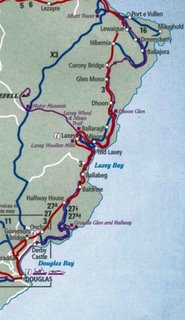 Well, the schedule says we’re off up the coast on board MV Karina, from Douglas past Laxey to Maughold to see railways, mines and lighthouses (see map on the left). But Captain Stephen Carter, of the Laxey Towing Company isn’t sure this is a good idea today, so he proposes a trip around the harbour instead.
Well, the schedule says we’re off up the coast on board MV Karina, from Douglas past Laxey to Maughold to see railways, mines and lighthouses (see map on the left). But Captain Stephen Carter, of the Laxey Towing Company isn’t sure this is a good idea today, so he proposes a trip around the harbour instead. 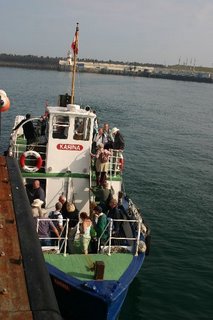 At first this seems a bit of a let-down, and could be boring… but there’s more to Capt Carter than just skippering, and he manages to entertain us with a virtual non-stop 2 hour commentary on items of maritime, IA and general historic interest, only stopping now and then to steer… (You can buy his book on the Douglas Harbour Ferries here)
At first this seems a bit of a let-down, and could be boring… but there’s more to Capt Carter than just skippering, and he manages to entertain us with a virtual non-stop 2 hour commentary on items of maritime, IA and general historic interest, only stopping now and then to steer… (You can buy his book on the Douglas Harbour Ferries here)
You can catch some of the commentary on the podcast - but here I’ll just cover some of the sights, with a bit of history as we go. You’ll have to excuse some of the pics being at a slight angle – Karina did bob up and down, and to and fro, quite a lot.
She was launched on 17th June 1946, with a maiden voyage on 27th July 1946 – so she’s just celebrated her 60th birthday. At 66 ft long, 14.9 ft beam, she’s just right for passenger cruises and is available for hire (licenced for 100 passengers). Construction is carvel planking over oak frames and she has a 127 bhp Gardner diesel engine. Book her here.
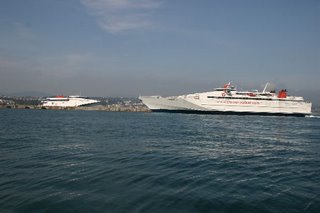 Now compare her to the big ferries of the Isle of Man Packet Company - today these tend to be the big ‘seacats’ – fast-speed catamarans – though as Capt Carter pointed out, that big one on the right, though called Superseacat, is actually a monohull. Confused? So’m I.
Now compare her to the big ferries of the Isle of Man Packet Company - today these tend to be the big ‘seacats’ – fast-speed catamarans – though as Capt Carter pointed out, that big one on the right, though called Superseacat, is actually a monohull. Confused? So’m I.
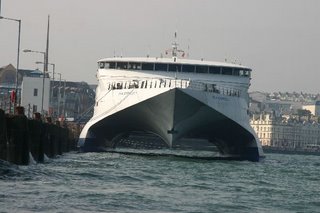 Anyway, the Steam Packet Company claims to be the oldest continually operating passenger shipping company in the world, founded in 1830 – which is quite impressive – full history is here. Many of their ships are named after Manx places and hills – one regular ship is the Ben-my-Chree, and many will know the song about the ill-fated Ellen Vannin, a company ship that sank in 1909. More about that on the podcast
Anyway, the Steam Packet Company claims to be the oldest continually operating passenger shipping company in the world, founded in 1830 – which is quite impressive – full history is here. Many of their ships are named after Manx places and hills – one regular ship is the Ben-my-Chree, and many will know the song about the ill-fated Ellen Vannin, a company ship that sank in 1909. More about that on the podcast
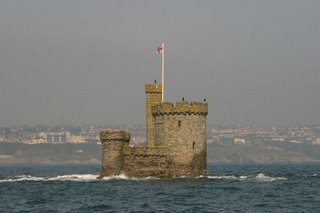 Next pic is of the ‘Tower of Refuge’ erected by Sir William Hillary in 1832 as a refuge for mariners wrecked on the Conister Rock in Douglas Bay. It looks like a spectacular folly, high and dry at low tide, yet surrounded by water at high tide. Sir William provisioned an upper room with blankets and food, but this custom has long been discontinued – it’s main function now seems to attract tourists, who sometimes get stranded. You may notice it is flying the Royal National Lifeboat Institution flag – this is because the RNLI were another inspired creation of Sir William. If you’re wondering about the fanciful name for the Tower, blame WilliamWordsworth - twas he who suggested it.
Next pic is of the ‘Tower of Refuge’ erected by Sir William Hillary in 1832 as a refuge for mariners wrecked on the Conister Rock in Douglas Bay. It looks like a spectacular folly, high and dry at low tide, yet surrounded by water at high tide. Sir William provisioned an upper room with blankets and food, but this custom has long been discontinued – it’s main function now seems to attract tourists, who sometimes get stranded. You may notice it is flying the Royal National Lifeboat Institution flag – this is because the RNLI were another inspired creation of Sir William. If you’re wondering about the fanciful name for the Tower, blame WilliamWordsworth - twas he who suggested it.
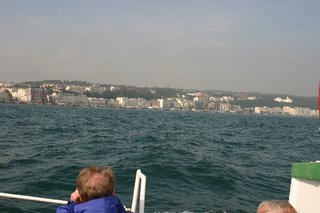 The tilted view is of Douglas promenade from the bay – the prom is a 19th century creation, built to cater for the tourists, and backed by uniform-looking (but actually all different) Victorian guest houses, now mostly knocked together in 3s and 4s to make bigger hotels. The land they, and the prom, are on was once the beach, and the street behind them is Strand Street, the original seafront. You’ll notice the Victorian frontage is getting a bit gappy and discontinuous, as new buildings are erected – including some big financial institution buildings, reflecting IoM’s ‘tax-haven’ status.
The tilted view is of Douglas promenade from the bay – the prom is a 19th century creation, built to cater for the tourists, and backed by uniform-looking (but actually all different) Victorian guest houses, now mostly knocked together in 3s and 4s to make bigger hotels. The land they, and the prom, are on was once the beach, and the street behind them is Strand Street, the original seafront. You’ll notice the Victorian frontage is getting a bit gappy and discontinuous, as new buildings are erected – including some big financial institution buildings, reflecting IoM’s ‘tax-haven’ status.
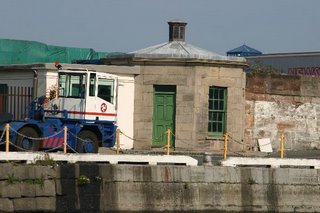 This little hexagonal building is part of the workings of one of the early piers for Douglas (many new piers and breakwaters have been built in the last few decades). I can’t remember exactly what it did just now – but I know Capt Carter mentions it on the podcast – so maybe I’ll let that speak for itself…
This little hexagonal building is part of the workings of one of the early piers for Douglas (many new piers and breakwaters have been built in the last few decades). I can’t remember exactly what it did just now – but I know Capt Carter mentions it on the podcast – so maybe I’ll let that speak for itself…
Other sites discussed include the new Millennium Bridge (see next but one blog entry) and the sad story of the Solway Harvester (see next blog entry).


0 Comments:
Post a Comment
<< Home